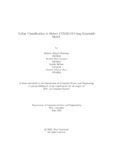| dc.contributor.advisor | Rahman, Md Khalilur | |
| dc.contributor.author | Solaiman, Ishmam Ahmed | |
| dc.contributor.author | Sanjana, Tasnim Islam | |
| dc.contributor.author | Sobhan, Samila | |
| dc.contributor.author | Maria, Tanzila Sultana | |
| dc.date.accessioned | 2021-10-25T06:46:52Z | |
| dc.date.available | 2021-10-25T06:46:52Z | |
| dc.date.copyright | 2021 | |
| dc.date.issued | 2021-06 | |
| dc.identifier.other | ID 19341012 | |
| dc.identifier.other | ID 19341011 | |
| dc.identifier.other | ID 17141018 | |
| dc.identifier.other | ID 17141004 | |
| dc.identifier.uri | http://hdl.handle.net/10361/15537 | |
| dc.description | This thesis is submitted in partial fulfillment of the requirements for the degree of Bachelor of Science in Computer Science and Engineering, 2021. | en_US |
| dc.description | Cataloged from PDF version of thesis. | |
| dc.description | Includes bibliographical references (pages 26-28). | |
| dc.description.abstract | Diagnosis with X-Rays and other forms of medical images has soared to new heights
as an alternative visual Covid infection detector. Radiographic images, primarily
CT scans and X-Rays images play massive roles in assisting radiologists to detect
and analyse severe medical conditions. Computer-Aided Diagnosis (CAD) systems
are used successfully to detect diseases such as tuberculosis, pneumonia and other
common diseases from chest X-ray images. CNNs have been widely adopted by
many studies and achieved laudible results in the eld of medical image diagno-
sis, having attained state-of-art performance by training on labeled data.This paper
aims to propose an Ensemble model using a combination of deep CNN architectures,
which are Xception, InceptionResnetV2, VGG19, DenseNet-201 and NasNetLarge,
that can aid in the diagnosis of various diseases using image processing and arti -
cial intelligence algorithms to quickly and accurately identify COVID-19 and other
coronary diseases from X-Rays to stop the rapid transmission of the virus. In our
experiment, we have used classi ers for the Xception model, VGG19, and Inception-
Resnet model. We have compiled a CXR dataset from various open datasets. The
compiled dataset was lacking 1000 images for viral pneumonia in comparison with
Covid-19 and Normal CXRs, We used image augmentation and focal loss to com-
pensate for the unbalanced data and introduce more variation. After implementing
the focal loss function, we were able to get better results. Moreover, we implemented
transfer learning on these models using ImageNet weights. Finally, we obtained a
training accuracy of 92% to 94% across all models. Our Accuracy of the Ensemble
Model was 96.25%. | en_US |
| dc.description.statementofresponsibility | Ishmam Ahmed Solaiman | |
| dc.description.statementofresponsibility | Tasnim Islam Sanjana | |
| dc.description.statementofresponsibility | Samila Sobhan | |
| dc.description.statementofresponsibility | Tanzila Sultana Maria | |
| dc.format.extent | 28 pages | |
| dc.language.iso | en | en_US |
| dc.publisher | Brac University | en_US |
| dc.rights | Brac University theses are protected by copyright. They may be viewed from this source for any purpose, but reproduction or distribution in any format is prohibited without written permission. | |
| dc.subject | Pneumonia | en_US |
| dc.subject | Coronavirus | en_US |
| dc.subject | Deep learning | en_US |
| dc.subject | X-Rays | en_US |
| dc.subject | Convolutional Neural Network | en_US |
| dc.subject | Ensemble model | en_US |
| dc.subject | Transfer learning | en_US |
| dc.subject | CAD | en_US |
| dc.subject.lcsh | Neural networks (Computer science) | |
| dc.subject.lcsh | COVID-19 (Disease) | |
| dc.title | X-Ray classification to detect COVID-19 using ensemble model | en_US |
| dc.type | Thesis | en_US |
| dc.contributor.department | Department of Computer Science and Engineering, Brac University | |
| dc.description.degree | B. Computer Science | |

